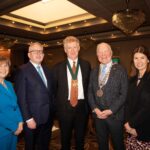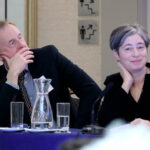Joint National Housing Conference opened in Waterford
The Joint National Housing Conference, in association with the Royal Institute of Architects of Ireland (RIAI), the Department of Housing, Local Government and Heritage (DHLGH) and Waterford City and County Council’s (WCCC) Housing Department opened in Waterford this week.
The national housing conference was first held in 1969 and every year since has explored the challenges, opportunities and innovations in housing design and delivery.
The theme for the two day conference was Diversifying and Expanding our Housing Delivery, with particular focus on emerging trends in planning, urbanism and architecture.
Mayor of Waterford City and County, Cllr. Joe Conway welcomed attendees to the Tower Hotel, Waterford saying, “I am delighted to welcome our esteemed speakers and guests to Waterford, Ireland’s Oldest City, for this two day event, who will no doubt inform, challenge and educate us all.
“This conference brings together planners, architects, academics, those in the construction industry and local authority housing teams who, day-in day-out, strive to create and shape sustainable, scalable communities, tackle dereliction and vacancy, and reinvigorate our villages, towns and cities.”
As a joint venture between the RIAI, WCCC and DHLGH, Minister for Housing, Local Government and Heritage, Darragh O’Brien TD said, “Over the years this conference has provided a strong networking and learning opportunity for architects, planners, and developers in the private sector to discuss emerging trends in the provision of both Social, Affordable and Private housing.
“It represents a valuable opportunity for them to meet with their professional counterparts and with housing practitioners in Local Authorities and Approved Housing Bodies, as well as with the professional advisors and colleagues from my own department. The success of Housing for All is dependent on us all – public and private sector – working together, and events like this are key to that collaboration.”
Speaking at the conference RIAI President Sean Mahon said, “This conference offers a unique opportunity for the built environment professionals in the public and private sectors to come together to discuss and develop innovative ideas for housing delivery. Housing is critical infrastructure required to sustain human well-being. Architects have a leadership role in driving innovation in housing design solutions the conference is an excellent opportunity to hear about new models and solutions that exist for housing delivery, but also to discuss the challenges impeding progress.”
The conference which was attended by architects and planners from across Ireland, the UK and Europe, addressed topics such as master planning, modern methods of construction, placemaking, repurposing buildings and policy context through a series of panel discussions.
Paul Johnston, Acting Director of Services for Planning at Waterford City and County Council spoke about how Waterford is tackling vacancy and is recognised as a national leader for its proactive efforts to bring urban vacant residential properties back into use. Under Rebuilding Ireland and Housing for All, the local authority is on track to bring over 700 previously vacated dwellings back into use.
Acting Senior Architects with Waterford City and County Council, Walter Holden and Morris Conway took part in a panel discussion on Town Centre First, a government initiative that aims to create town centres as vibrant and attractive locations for people to live, work, and visit, while also functioning as the social, cultural and recreational hub for local communities. The public realm improvements, varied cultural offerings, and return to use of vacant properties have combined to bring a unique sense of life to the city centre, and this was acknowledged in the Irish Times Best Place to Live Award, recently bestowed to Waterford.
Former Senior Architect with Waterford City and County Council, Rupert Maddock spoke about ‘Learning from Waterford.’ Rupert was recently awarded the RIAI Gandon Medal for his contribution to the advancement of architecture. Transformational public realm projects, spearheaded by Rupert include the Millennium Project, which entailed the design of the William Vincent Wallace Plaza, and the design of John Roberts Square, creating a pedestrianised, decluttered and multi-purpose destination public realm space.
In addition to projects such as the redesign, development and conservation of the People’s Park, the Clock Tower, the Franciscan Friary and Mount Congreve, Rupert’s passion and undoubted forte is the preservation of Waterford’s rich history and heritage.
Under his tenure, Waterford has cultivated an enviable portfolio of museums, under the Waterford Treasures collective, which includes the Medieval Museum, The Bishop’s Palace, The Irish Museum of Time, the Irish Silver Museum and the latest addition, The Irish Wake Museum.
The conference valedictory topic was ‘Towards the Ideal Town in Ireland’ delivered by Professor Daniel Miller, a professor of anthropology at University College London and a visiting professor at UCD.
-ends-
Images attached: Noel Browne
2: Paul Johnston, WCCC Acting Director of Services for Planning, Rupert Maddock, former WCCC Senior Architect, WCCC Acting Senior Architects Walter Holden and Morris Conway
15: Former Senior Architect with WCCC Rupert Maddock spoke about ‘Learning from Waterford.’
5: Paul Johnston, WCCC Acting Director of Services for Planning, Gary Falconer and Patricio Harte of CJ Falconer and Associates.
12: Paul Johnston, WCCC Acting Director of Services for Planning and Noelle Sweeney Housing Agency
Image attached: John Power
DHLGH_RIAI: Áine Stapleton, Assistant Secretary DHLGH; Graham Doyle, Secretary General at Department of Housing, Local Government and Heritage; Sean Mahon, RIAI President ; Mayor of Waterford City and County, Cllr. Joe Conway and Kathryn Meghen, RIAI CEO.






